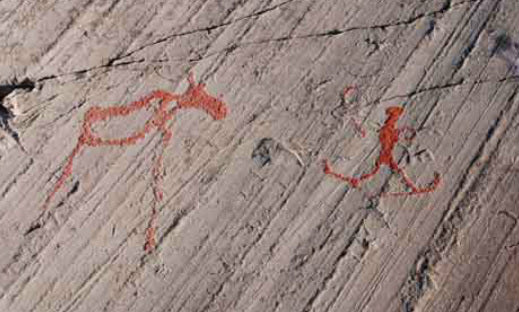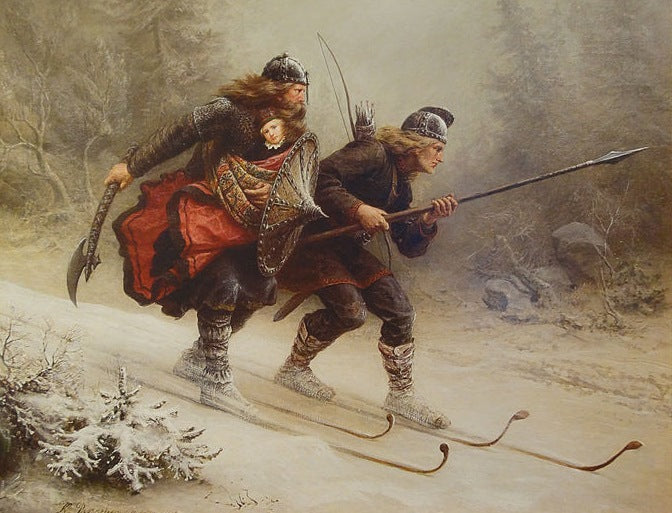History of Skiing
Presented by Free the Powder Ski Gloves

Pre-Historic Skiing
The history of skiing traces all the way back to ancient times, with rock paintings and sets of skis preserved in bogs dating back to the period between 8000 - 6000 BC. The first community believed to have skied were the ancestors of the Sami, the only indigenous people to Scandinavia.

6300 BC - Russia
The oldest set of skis were found near Lake Sindor in Russia ("Vis" archaeological sites). The Vis sites are two peat bogs near Lake Sindor in the Vychegda basin of Russia. Specific items discovered include the remains of worked wooden objects -wooden skis and sled runners- .

3000 BC
Rock paintings in Russia and Scandinavia confirm a history of skiing by the people of that time.

2500 BC
A rock carving of a skier was found in Rodoy, Norway. The age of the carving was established using carbon dating.

1300 BC
Norse mythology writings began about Ullr and Skade, the God and Goddess of Skiing.

1206 A.D
Norwegian military skiers, the Birkebeiners (Thorstein Skevla and Skjervald Skrukka) carry the King’s heir, 2-year old Haakon Haakonson, to safety over the Dovre Mountains from Lillehammer to Osterdalen during a Civil War, thus creating one of the most famous legends in backcountry skiing history. Since 1932, the famed Birkebeiner race has continued along the same route from Rena to Lillehammer.

1600-1799
1689- Accounts of skiing begin to show up in published works, including Austrian Valasavor's Die Ehre des Herzogtumes Krain. He writes about skiers near the Adriatic using short skis to turn on steep slopes.
1716- Use in war. Great Northern War between the Russians, Swedes and Norwegians was fought primarily on skis.
Later 1700s- Sometime in the 18th century skiing began its evolution as a recreational sport in the Telemark region of Norway. They invented styles of turning to control speed, the Telemark turn and the Christie. The focus on speed led to changes in the design to narrower and lighter construction.

Early 1800s
The design of the ski continued to progress through the early 1800s and took a big leap forward with the invention of the cambered ski. The cambered ski bends toward the center (concave), allowing the ski to distribute the weight of the skier more evenly across the length of the ski. Before this novel concept, skis were made thick and heavy to glide without the ski bending and sinking in the middle. The thinner, lighter cambered ski floated more easily over soft snow and flexed much better, dramatically improving shock absorption and easy of turning.

Mid 1800s
1841- First documented use of recreational skis in USA, in Beloit, Wisconsin.
1860s- Alpine ski racing as an organized sport begins in North America and Norway.
1870s- Ski Clubs begin to flourish in Europe and in North America.
1878- At the Exposition Universelle in Paris, the Norwegians presented a display of skis. This ancient mode of transportation became a popular souvenir.
Skiing spread across Europe from North to South.

Late 1800s
1880s- The first hickory skis were produced in Norway. Modern carbon and steel tools made it possible to shape the extremely tough and hard hickory. This made it possible to produce even thinner, lighter skis with better flex. The toughness also resisted dings and scars from the bases hitting rocks. Hickory was imported at great expense from the United States. This did not escape the attention of Norwegian immigrants in the upper Midwest (Wisconsin and Minnesota) and soon much of the early ski making industry moved to the US.
1890s- The first two-layer laminated ski were made with a hickory base and a lighter body of spruce or basswood. This made the ski lighter, more flexible and dramatically decreased the cost of using expensive hardwoods. The problem: the glue was not waterproof so de-lamination came quick.

Early 1900s
1905- The U.S. Ski Association (USSA), the governing body of Olympic snowsports, is founded.
1924- The Federation Internationale de Ski (FIS) is founded and Nordic events are held at the first Olympic Winter Games in Chamonix, France.

1920-30s Innovations
1928- The steel edge was invented by Rudolph Lettner of Salzburg, Austria. This gave skis much better grip on hard snow while still allowing the wood to flex naturally. Durability was poor in the early years, (the screws tended to fall out) forcing skiers to carry spare edges.
Late 1920s- The use of Aluminum in skis begins its development.
1932- The first successful three-layer laminated skis were invented. But this time around, the skis did not de-laminate easily due to the use of waterproof glues made from milk protein. The first of these skis were marketed under the Splitkein label in Norway and as Anderson & Thompson skis in the U.S.
1937- The most significant invention in the history of modern skis - better glue. R.E.D. Clark of Cambridge, England, invented the formaldehyde-based adhesive Aerolite to hold airplanes together. This would revolutionize ski construction and set the stage for metal and plastic skis.

1936
The first chairlift created and installed in Sun Valley, Idaho, USA.

1940-50s Innovations
1941- The first cellulose plastic base is made in France, to go on Dynamic skis.
1945- The first manufactured aluminum ski. Three aircraft engineers Wayne Pierce, David Richey and Arthur Hunt, build an aluminum-laminate ski with a wood core.
1949- Howard Head created the most commercially successful early metal ski. It was a pressure-bonded aluminum ski with a plywood core, plastic side-walls and continuous integral steel edges. It was the first successful ski made of very different components. The secret of the ski's construction was a flexible contact cement that allowed the different layers to shear against each other without weakening. The revolution of metal and plastic was underway.
1952- First man made snow was created at Grossinger’s Resort in New York.
1955- The first polyethylene base is introduced in Austria, eliminating the need for wax. A similar material made in Switzerland was marketed under the brand name P-Tex. It was widely adopted by ski factories, and supplanted earlier plastic bases.
1959- The first successful plastic fiberglass ski was invented by Fred Langendorf and Art Molnar. By 1968, fiberglass ski had supplanted both wood and aluminum for use in most skis.

1960-70s
1962- The invention and spread of plastic-shelled ski boots. Invented by Bob Lange.
1967- The World Cup of ski racing was created by U.S. Ski Team Coach Bob Beattie, French Ski Team Coach Honore Bonnet and French journalist Serge Lang.
1970s- the age of advancement in materials. Improvement in plastics, fiberglass, use of Kevlar, carbon fiber, ceramic fiber and other high-strength materials improve strength, resilience, damping, and torsion. Sintered polyethylene begins to replace extruded polyethylene as a tough, wax-retentive, high-speed base material.

1980s
The widespread distribution of ski films, pioneered by Warren Miller, and the growth of the ski vacation industry. Skiing became the primary industry in the mountain communities of the Western and Northeast U.S.

1990s
The revolution of the shaped ski, making turning the ski much easier. Widespread installation of high-speed detachable chairlifts.

2000s
The revolution of the fat, wide ski, making skiing in deep snow much easier. This further led to the explosion of popularity in powder skiing,

2010-Present
The revolution of ultralight construction evolves from the explosion of popularity in backcountry skiing. Lighter plastics, carbon fiber and woods such as poplar and paulownia replace heavier materials.

The Future?
Who knows, perhaps rocket packs to eliminate the chairlifts.
And that is the history of skiing...
But what about the history of the late 20th century split in the sport into skiing and snowboarding?
Learn more about snowboarding's history
References:
Why Free the Powder?
-
Premium Quality
We use the best quality leather and the most breathable materials in order to make the warmest and toughest ski gloves and mittens.
-
Superior Value
Why pay a triple digit markup for quality? We sell our premium leather ski gloves direct at lower prices than our competitors.
-
Free Same-Day Shipping
No one wants to wait for their order to ship. You'll get your gloves and mittens fast! We get your order out to you ASAP.

